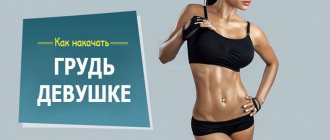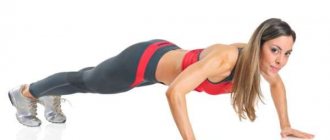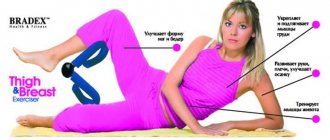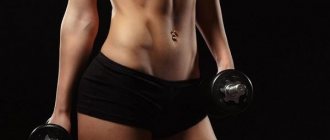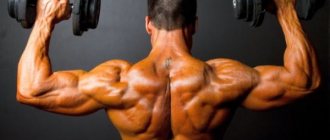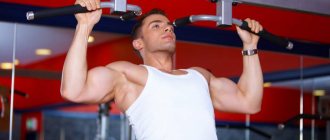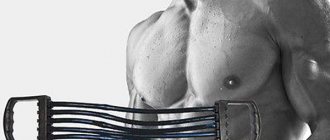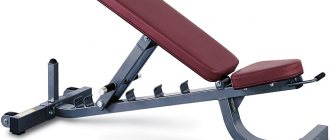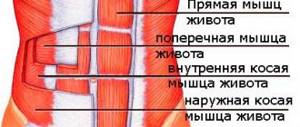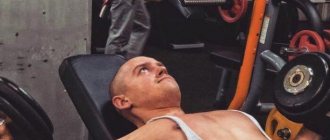All novice athletes are interested in how to quickly pump up their pectoral muscles at home. A large number of beginners do not know how to do push-ups from the floor correctly so that the pectoral muscles receive a sufficiently effective load and begin to grow, or they do not have the knowledge of how to properly do pull-ups on the horizontal bar so that the muscle fibers of the chest are well worked.
To properly pump up different muscle groups of the body, chest, you need proper nutrition and systematic training. All of these measures will lay the foundation for building powerful and muscular pecs.
By performing special and effective exercises, you can quickly give your breasts the desired shape and aesthetic appearance. Pumping up the pectoral muscles at home means regular training at least 2-3 times a week.
By following the rules and performing systematic chest exercises, you will achieve the desired result in the shortest possible time. And most importantly, desires and self-confidence.
A little anatomy
The pectoral (pectoral) muscles consist of the following symmetrical groups, each of which includes:
- Pectoralis major muscle. It is fan-shaped and located on the front surface of the chest.
- Pectoralis minor muscle. It has a triangular shape and is located in the upper chest under the pectoralis major muscle.
- Serratus anterior muscle. Located in the anterior chest wall.
The major and minor muscles provide adduction and flexion of the arms at the shoulder joint, as well as partial rotation of the arms inward. The chest is conventionally divided into upper, middle and lower sections. There is also an internal part that can be pumped separately. The middle part works actively during any exercise, and the lower and, especially, the upper parts require accentuated load. Chest training is very energy-intensive, so it can be used to burn excess fat deposits.
Home workouts
A busy work schedule, business trips, inconvenient location of the gym, reluctance to work out in a group and a number of other arguments may become reasons not to visit the gym, but should not become reasons to give up a beautiful and strong figure. You can practice at home with no less success. What matters more is not the place of training, but the diligence and determination of the athlete.
Next, we will figure out how to pump up the pectoral muscles at home. Beginners often have difficulty creating a program, but as they gain experience, the problems will disappear.
Recommendations for men to burn fat on the pectoral muscles
We offer useful tips that will help you get rid of fat deposits on your torso and tighten your chest.
- Visit an endocrinologist. Sometimes the cause of breast enlargement in men is gynecomastia. This disease is characterized by the proliferation of mammary glands. Gynecomastia develops due to hormonal imbalance.
- Avoid fast food. Foods rich in carbohydrates can lead to obesity. But you don't need to give up carbohydrates completely. Reduce the content of “coals” in your diet to 45% and eat them before 14.00. Please note that these should be healthy cereals, not white bread.
- Move more. Those who lead a sedentary lifestyle have an increased risk of developing obesity. Do at least 3 moderate cardio workouts per week. This could be jogging, race walking, swimming or just walking in the park.
- Get rid of swelling. Excess weight, and with it “female breasts,” in some cases appear due to swelling. Only a doctor can determine the exact cause of swelling. But now you can reduce your salt intake, which will slightly reduce body swelling.
Training mode
To the question of how many times a week you need to pump up your pectoral muscles, the answer is simple: you can’t train every day. Any strength exercises on the chest performed every day can harm a beautiful figure. During training, the muscles actively work and receive many microtraumas, after which time is needed to restore muscle fibers and produce protein, which will form new muscle mass. Systematic overload of the pectoral muscles will not give good results.
If the muscles continue to hurt severely, exercise should be postponed until the discomfort stops. That is why the optimal amount is one or two workouts per week. The total number of approaches for all chest exercises should be from 4 to 8. For beginners, one or two exercises of 2-3 approaches will be enough.
Video on how to burn fat on the pectoral muscles for a man
You can often find men whose mammary glands are quite developed. This suggests that such people have a large number of fat cells.
Moreover, this phenomenon does not mean at all that the man is unfamiliar with physical activity or that he is not eating properly.
The fat layer on a man’s chest can grow as a result of hormonal imbalances or as a result of various pathological processes. Most often, fat in this area appears under the influence of external factors, so the situation can be corrected.
Pushups
It is quite enough to do push-ups regularly to pump up your pectoral muscles. Essentially, this is a variation of the bench press and here it is also possible to shift the load to the upper or lower chest by changing the angle of the body. It's no secret that push-ups are an excellent general development exercise. Not only the chest is worked, but also the deltoids and triceps, ensuring proportional development of the upper body. Additionally, the abdominal muscles contract, and in a static position the muscles of the legs and back are activated. Wide-arm push-ups work the chest muscles to a greater extent than the shoulder girdle and arms.
You can limit yourself to just push-ups if you want to pump up your chest at home, but there is no desire or time to do other exercises. The effect, although small, will still be felt after just a few weeks of regular training.
Pump up your chest
Oddly enough, not only girls, but also men want to pump up their breasts The principles of training are directly opposite, this applies to all muscle groups, but especially in this case. If women focus on the upper bundle of pectoral muscles and stretching exercises, then men increase the mass of the lower bundle of pectoral muscles, but first things first.
The pectoral muscles are a large muscle group, which is conventionally divided into three parts: the upper pectoral muscles, the lower chest and the middle of the chest. This is important to know in order to pump up your breasts. The lower part of the pectoral muscles is the most developed genetically, therefore it steals the lion's share of the load.
This happens always and everywhere - a stronger muscle, other things being equal, always takes on more load than weaker muscles. In this way, the body saves energy, and it uses weaker muscles only when a strong muscle can no longer cope with the load.
Therefore, in order to pump up the chest evenly, the athlete has to perform special exercises that force the body to pump those areas of the pectoral muscles that it usually does not strain.
To do this, use an inclined bench, hand position, dumbbells and other tricks.
But training the pectoral muscles varies in its objectives; it can pursue the goal of building muscle mass, adjusting proportions, increasing strength and “drying”. In this regard, the training program will differ.
Pump up your chest: mass
To build muscle mass in the pectoral muscles, you must perform basic exercises, with an emphasis on the target muscles. The first thing here is technology. If, when training strength indicators, you must include many muscle groups, then the situation is exactly the opposite.
You can pump up your chest with three exercises: bench press, angled press, and wide-grip parallel bars with additional weights. In this case, it is necessary to observe microperiodization.
The chest can be pumped twice a week, with training programs aimed at pumping the chest.
It will be best if at the beginning of the week you do the bench press for four working sets of 8 reps, and at the end of the week, two days before your next chest workout, weighted bars and incline presses in the 12 rep range.
Pay attention!
This training scheme will allow you to progress the load, on the one hand, and on the other hand, pump up lagging areas of the pectoral muscles, which will make it possible to evenly pump up your chest.
The leading bundle of the pectorals is the lower chest, the top and middle lag behind. Therefore, the athlete should perform the bench press, which pumps up the bottom, with a barbell, and the angled press with dumbbells.
Weighted bars help to pump up the middle of the chest perfectly.
When training for mass, you must perform the exercise with appropriate technique. During the bench press, your feet should be on the bench, and your elbows should be spread out to the sides so that when the barbell touches your chest, they form an angle of 90°. Using dumbbells while pressing at an angle will allow you to engage the stabilizer muscles, which will help deepen the load.
But you shouldn’t do isolation exercises! Leave this until you get around to adjusting the proportions.
Now remember , we train only with basic exercises, we train the chest twice a week, we don’t try to take more weight than we can, but we monitor the technique and focus the load on the pectoral muscles. Follow these rules, and pumping up your breasts will not be difficult!
Pump up your breasts: quality
Unlike gaining muscle mass, where the athlete is interested in the massiveness of the muscles, in this case they are interested in their shape. There are two reasons why an athlete may wonder about adjusting their proportions: some area of the pecs is lagging behind, or the athlete has a narrow bone structure.
In the first case, either the upper bundle of the pectoral muscles or the middle of the chest may lag behind. Accordingly, it is necessary to do the exercises that can help restore the imbalance. First of all, these are angled presses and weighted parallel bars. But the bench press will have to be excluded. Instead of the bench press, include the head down press and dumbbell flyes in your training program.
You already know the functions that parallel bars and an angle press perform - these exercises allow you to pump up your chest.
Dumbbell flyes allow you to stretch the pectoral muscles and place a good emphasis on the load in the middle of the chest.
It is important!
The upside down press pumps up the bottom of the chest and feet, but just now we were talking about the fact that the bottom of the chest is always in the lead anyway! Right! But this exercise will help to draw the bottom of the pectoral muscles, lifting the chest up.
To expand your core, you will have to devote a separate workout. It is important to note that pumping your breasts in this way only makes sense if your growth zones have not yet closed, which means up to 25 years.
The essence of the training is to expand the chest. To do this, you will need a superset, which consists of squats with a barbell and a pullover.
This workout will not only pump up your chest, but will enhance the effectiveness of all chest muscle training.
Barbell squats should be performed with a light weight in the 20 rep range while breathing deeply. You may even need the pranayama technique, you should inhale as deeply as possible and exhale quickly with effort.
One repetition should take at least 6 seconds. After you do a set of squats, you need to move on to the pullover.
You will also perform the pullover while breathing deeply, doing the exercise for at least 12 repetitions in one approach.
Perhaps, mass training and chest correction can be combined into one system, in which at the beginning you pump up muscle mass, and then correct their shape. It is important to follow the correct technique, which allows you to improve neuroconnection, and the sequence of training.
Helpful advice!
But remember that these are the basic rules for training the pectoral muscles; in order to pump up your chest or other muscle group, you need to choose the right training program that will suit you. After all, you may enter a phase of overtraining, or a plateau, perhaps you have reached your genetic limit, etc.
Interesting: What is the best way to pump up your breasts?
Therefore, following the basic training recommendations, choose the training program that will be most effective for you at the moment.
Pump up your chest: strength
It is necessary to train the strength of the pectoral muscles by performing basic exercises, but unlike mass training, in a low frequency number of repetitions. We're talking about the bench press.
In this case, the exercise technique will be specific, you will have to make a bridge, bring your shoulder blades together, turn your elbows towards the body, lowering the barbell, you will touch the solar plexus, and your hands will be pressed to the body.
With this technique, most of the load will be received by the triceps, latissimus dorsi, legs and shoulders, which does not really help pump up the chest. But you will be able to lift more weight, which will stimulate your fast-twitch muscle fibers to grow. Often bodybuilders neglect this technique, because this is an exercise for powerlifters, but they do it in vain. The fact is that micro and macro periodization are very useful.
The more varied load you give your muscles, the more effective the workout. The body has to adapt, so you are less likely to hit a plateau.
Since the load is different, the chance of overtraining is also less. Moreover, by increasing strength indicators, you will be able to more easily progress the load when training your chest for weight.
Therefore, it is easier to pump up your chest by training different muscle qualities than to “pound” the same training program.
"Drying"
It is necessary to train your chest even when you are trying to burn subcutaneous fat. But getting rid of excess weight is not a matter of a training program, but a matter of dieting for weight loss.
In this case, a sports diet would be the most appropriate; as for the pectoral muscles during this period, the training program should be aimed at preserving muscles, and not at getting rid of fat, and it is even more pointless to try to pump up the chest.
Forget about aerobic exercise! If you do not take anabolic steroids, you will simply “burn” all your muscles. On the contrary, you should train with heavy training weights. It is best to do the bench press for 6-8 reps.
Otherwise, in conditions of calorie deficit, the body will use muscle rather than fat as energy.
Muscles are full of glycogen, so if you don’t force your body to think that muscles are vital to it, then it will “eat” them first.
Build muscles
Source: https://Fit4Power.ru/shema/nakaceatigrudi
Narrow push-ups
Narrow push-ups can be used to develop strength and work the inner chest. The starting position in this case is the same as for regular push-ups, but you need to place your hands in such a way that the fingers of one hand slightly touch the fingers of the other. When performing, you need to lower yourself until your chest touches your hands, and before moving up, take a second pause.
Advice! If push-ups are too easy, do not increase the number of repetitions; it is better to use additional weights. For this you can use, for example, a backpack with books.
Push-ups on stools
A more effective way to pump up your pectoral muscles with push-ups is as follows. You need to place 2 stools approximately shoulder width apart. Take the starting position, as when doing push-ups from the floor, only place your hands on stools and your feet on the floor or on a raised platform, for example, a sofa or chair. Place your palms slightly wider than your shoulders.
Going as low as possible between the stools, perform 3-4 sets of 10-12 push-ups. Breaks between approaches should be approximately 2-3 minutes.
Forward Bend Push-Ups
The essence of the exercise is to place your legs above the level of your head. To do this, focus on your outstretched arms, placing them shoulder-width apart. Place your feet on a stool, sofa or other accessible elevation. This version of the exercise increases the load on the upper chest, and also uses the triceps and deltoids.
As for how to pump your chest correctly, when doing push-ups from the floor, try to spread your elbows to the sides to provide more load to the chest muscles rather than the triceps. This way, you can pump up your chest faster with push-ups.
How to speed up progress with sports nutrition?
All exercises for men aimed at pumping up muscles are performed according to a certain principle. It is necessary to achieve a failure repetition when another repetition in the same approach is impossible. This principle triggers the mechanism of muscle protein synthesis. Therefore, it is necessary to eat well and rationally. It is believed that you need to consume 1.5-2 g of protein per 1 kg of body weight. If this amount of protein cannot be achieved with regular food, then you can use sports nutrition - various types of protein. For particularly thin people, you can also use gainers, which allow such people to gain muscle mass faster.
For those who are just deciding whether they need sports nutrition, we recorded a video below:
